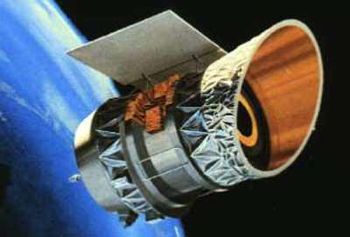
Home - Search - Browse - Alphabetic Index: 0- 1- 2- 3- 4- 5- 6- 7- 8- 9
A- B- C- D- E- F- G- H- I- J- K- L- M- N- O- P- Q- R- S- T- U- V- W- X- Y- Z
IRAS
 IRAS Credit: Manufacturer Image |
AKA: InfraRed Astronomical Satellite;PIX. Status: Operational 1983. First Launch: 1983-01-26. Last Launch: 1983-01-26. Number: 2 . Gross mass: 1,073 kg (2,365 lb).
IRAS was conceived and built by the Netherlands, with the US providing the satellite platform and telescope. IRAS was built by Fokker and Hollandse Signaal in cooperation with the NLR, the Dutch Aerospace Research institution.
IRAS started life as ANS-B, the successor of ANS (Astronomical Netherlands Satellite), the Netherlands first independently-built satellite. ANS was also a space telescope. but in the ultraviolet / X-ray spectrum. Many elements which were developed for ANS were used again in IRAS. The on-board computer, developed by Philips / Hollandse Signaal, was an improved version of the one on ANS.
During development it became clear that cooperation with the US would provide a much better option than the Dutch doing it all by themselves. The British provided the data telecommunications system.
NASA NSSDC Master Catalog Description
The Infrared Astronomical Satellite (IRAS) was a mission with joint execution by the United States (NASA), the Netherlands, and the United Kingdom. The basic goal of this mission was to obtain a full-sky survey over the approximate wavelength range 8 to 120 micrometers with four broadband photometry channels. IRAS increased the number of cataloged astronomical sources by about 70%, detecting about 350,000 infrared sources, and its numerous discoveries included revealing for the first time the core of our Milky Way galaxy. The satellite design and survey strategy were optimized for maximally reliable detection of point sources. Pointed observations, known as Additional Observations or Aos, were interspersed with survey observations. IRAS contained a 0.6 m Ritchey-Chretien telescope cooled by helium to a temperature of near 10 K. An array of 62 detectors was used to detect the infrared flux in bands centered at 12, 25, 60, and 100 micrometers. The noise equivalent flux densities were, respectively, 0.1, 0.1, 0.1, and 0.3 Jy (1 Jansky = 1E-26 W/sq m-Hz) in the four survey bands. The positions of galactic and extragalactic sources were determined to an accuracy of 0.5 arc-min. In addition to the focal-plane detector array used for the all-sky survey, a low-resolution spectrometer and a 60-and 100-micrometer chopped photometric channel were included on IRAS. To scan the sky for the survey, the satellite was rotated at a constant angular velocity perpendicular to the satellite-sun vector. IRAS could be pointed also at a selected celestial object for up to 12 min. This pointing ability permitted observations of selected objects with up to a factor of 10 increase in sensitivity or spatial resolution compared to that of the survey. IRAS ceased operations on November 21, 1983. Further discussion of the IRAS mission can be found in G. Neugebauer et. al., Science, v. 224, pp. 14-21, 1984, and in the entire March 1, 1984 issue of Astrophysical Journal Letters (v. 278, pp. L1-L85).
More at: IRAS.
Family: Astronomy, Infrared astronomy satellite, Sun synchronous orbit. Country: USA. Launch Vehicles: Thor, Delta, Delta 3910, Delta 3000. Launch Sites: Vandenberg, Vandenberg SLC2W. Agency: NASA. Bibliography: 2, 279, 6, 6596, 12671.
1983 January 26 - . 02:17 GMT - . Launch Site: Vandenberg. Launch Complex: Vandenberg SLC2W. LV Family: Thor. Launch Vehicle: Delta 3910.
- IRAS - . Payload: IRAS / PIX 2 #. Mass: 1,073 kg (2,365 lb). Nation: USA. Agency: JPL, NIVR. Class: Astronomy. Type: X-ray astronomy satellite. Spacecraft: IRAS. USAF Sat Cat: 13777 . COSPAR: 1983-004A. Apogee: 903 km (561 mi). Perigee: 885 km (549 mi). Inclination: 99.00 deg. Period: 102.90 min. All-sky survey of astronomical IR bodies. Spacecraft engaged in research and exploration of the upper atmosphere or outer space (US Cat B). .
- PIX 2 - . Payload: PIX II. Mass: 1,073 kg (2,365 lb). Nation: USA. Agency: NASA Greenbelt. Spacecraft: IRAS. USAF Sat Cat: 13778 . COSPAR: 1983-004B. Apogee: 887 km (551 mi). Perigee: 856 km (532 mi). Inclination: 100.03 deg. Period: 102.30 min.
Back to top of page
Home - Search - Browse - Alphabetic Index: 0- 1- 2- 3- 4- 5- 6- 7- 8- 9
A- B- C- D- E- F- G- H- I- J- K- L- M- N- O- P- Q- R- S- T- U- V- W- X- Y- Z
© 1997-2019 Mark Wade - Contact
© / Conditions for Use